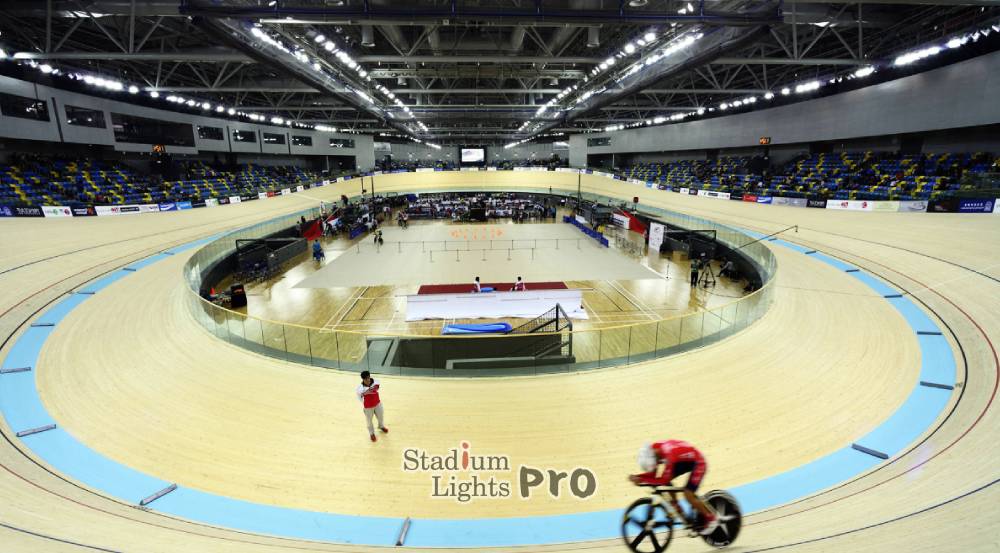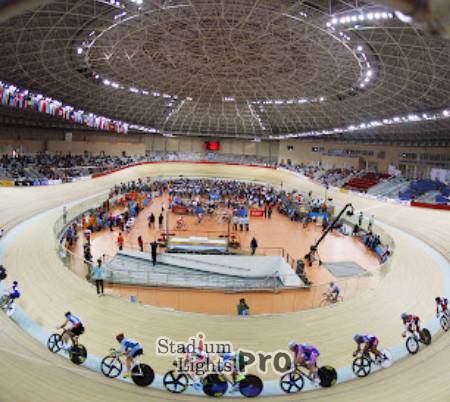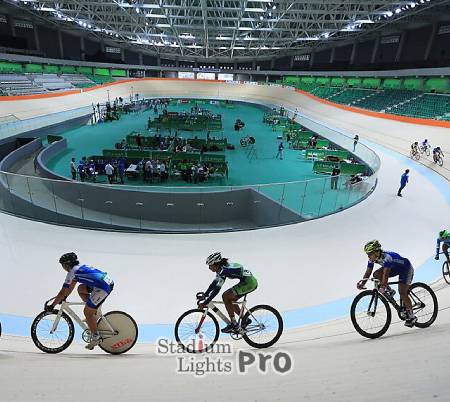The design and quality of lighting in a velodrome are fundamental to ensuring that athletes perform at their best while spectators have an optimal viewing experience. However, poor lighting conditions can cause discomfort and even hinder performance. A major challenge faced in velodrome lighting is the presence of glare. Glare is a visual disturbance that can impair vision, distract athletes, and create safety risks. To mitigate these issues, anti-glare lighting systems have been developed. These systems enhance visibility while improving the safety and comfort of athletes and spectators alike. The importance of reducing glare in velodrome lighting cannot be overstated, as it directly influences both the athletic performance and the overall experience within the venue.

Table of Contents
ToggleUnderstanding Glare and Its Impact
The Nature of Glare
Glare occurs when excessive or poorly directed light interferes with visual tasks. In a velodrome, glare can affect cyclists’ ability to focus on the track, potentially leading to accidents or mistakes during a race. It can also cause discomfort to spectators, especially those in the stands, making it harder to follow the race. Glare is most commonly caused by overly bright light sources or poor distribution of lighting across the track.
Glare’s Effects on Athletes
Cyclists are required to maintain focus and precision throughout a race. The track’s visibility is central to this focus, and any distortion or discomfort caused by glare can reduce performance. Cyclists may be momentarily distracted by bright spots or inconsistent lighting, which can impact their speed and accuracy in taking turns or adjusting their position. In some cases, glare can even lead to collisions or falls if an athlete’s line of sight is compromised, especially at high speeds where reaction times are minimal.
Glare’s Effects on Spectators
For spectators, glare can make it difficult to clearly see the action. Bright lights that are improperly positioned or overly intense can cause discomfort, especially when reflected off surfaces such as the track or barriers. This can detract from the spectator experience, potentially diminishing the enjoyment of the event. Ensuring that the lighting is well-balanced and does not cause discomfort for the audience is just as important as focusing on the athletes.
Anti-Glare Lighting Systems
Benefits of Anti-Glare Technology
 Anti-glare lighting systems are designed to address the discomfort and safety issues caused by excessive light intensity. By targeting the areas where light can cause visual disruption, such as the eyes of athletes and spectators, these systems significantly reduce the harshness of lighting. When applied in a velodrome, anti-glare technology ensures that the light does not create spots of intense brightness or overly dark patches that can confuse the viewer or the competitor. Instead, it softens the light distribution and creates a more uniform environment where clarity is optimized.
Anti-glare lighting systems are designed to address the discomfort and safety issues caused by excessive light intensity. By targeting the areas where light can cause visual disruption, such as the eyes of athletes and spectators, these systems significantly reduce the harshness of lighting. When applied in a velodrome, anti-glare technology ensures that the light does not create spots of intense brightness or overly dark patches that can confuse the viewer or the competitor. Instead, it softens the light distribution and creates a more uniform environment where clarity is optimized.
These systems work by redistributing the light across the space, ensuring that all areas of the track are illuminated evenly. This is particularly important in a fast-paced environment like a velodrome, where cyclists are navigating the track at high speeds. The constant movement combined with high-intensity lighting can lead to sudden contrasts of light and shadow, causing distractions and impairing focus. By reducing these sudden changes in lighting intensity, anti-glare systems allow athletes to maintain their focus on the track, minimizing visual distractions. Similarly, spectators benefit from a more comfortable viewing experience, free from discomfort caused by overly bright or fluctuating light levels. Whether an individual is following the race from a distance or closely observing the athletes, the experience is improved with lighting that does not strain the eyes or cause discomfort.
Furthermore, anti-glare technology improves safety. In a velodrome, where the margin for error is incredibly small and the speed at which cyclists compete is intense, any visual interference can lead to accidents. Athletes may misjudge distances or lose track of their surroundings if they are distracted by glare. Anti-glare systems help reduce these risks by ensuring that lighting is neither too harsh nor uneven, providing clear visibility across the entire track. This contributes to both the performance of the athletes and the overall safety of the event.
Improved Lighting Design
To combat glare effectively, the design of the lighting system is of utmost importance. In the past, velodromes and similar venues often relied on large, concentrated light sources that created bright spots and deep shadows. These older systems had limited control over the light output, which often led to a harsh contrast between different parts of the venue. When light is focused too directly, it not only creates glare but also leads to unwanted reflections off surfaces like the track or barriers. This makes it difficult for both athletes and spectators to maintain a clear and consistent view of the event.
The modern solution is the incorporation of advanced optics in the lighting design. Anti-glare lighting systems utilize diffusing lenses or reflectors that soften the light, dispersing it more evenly across the velodrome. This ensures that the light is not concentrated in small spots but is spread over a wider area, reducing the intensity and preventing the creation of harsh shadows. The design process focuses on ensuring a smooth transition between different areas of the venue, eliminating the stark contrasts that can be so jarring in more traditional systems. When light is distributed in this manner, it creates a consistent and uniform environment that feels natural and less disruptive to those present.
Moreover, the use of LED lights with built-in anti-glare capabilities has revolutionized lighting systems in velodromes. Unlike older lighting technologies, such as halogen or incandescent bulbs, LED lights can be customized with anti-glare lenses to direct and diffuse the light in very specific ways. LED lights are highly versatile, allowing for precise control over both the intensity and spread of light. By incorporating these types of lighting into velodrome systems, designers can create a much more controlled and glare-free environment. The result is a significant reduction in glare, along with more focused, efficient lighting that still provides the brightness needed for visibility, while ensuring a safe and comfortable experience for both competitors and spectators.
The integration of advanced optics and LED lighting not only helps mitigate glare but also improves the overall aesthetic of the venue. As the light is distributed evenly, it enhances the clarity of the track, allowing for a clearer view of the cyclists’ movements and better visibility of other elements, such as the scoreboard or surrounding structures. This uniformity in lighting fosters a more enjoyable and engaging experience for everyone involved in the event, from the athletes to the audience.
Proper Light Placement and Angle
 Another crucial component in reducing glare is the careful placement and precise angling of light fixtures. In a velodrome, the track is typically a curved, dynamic surface, with athletes moving at high speeds in a circular motion. This requires that the lighting system be customized to meet the unique needs of such a venue. The placement of lights must be strategic, ensuring that no areas of the track are underlit or overly illuminated. An effective anti-glare system will consider the track’s curvature, the angles at which cyclists approach different sections, and the viewing positions of the spectators.
Another crucial component in reducing glare is the careful placement and precise angling of light fixtures. In a velodrome, the track is typically a curved, dynamic surface, with athletes moving at high speeds in a circular motion. This requires that the lighting system be customized to meet the unique needs of such a venue. The placement of lights must be strategic, ensuring that no areas of the track are underlit or overly illuminated. An effective anti-glare system will consider the track’s curvature, the angles at which cyclists approach different sections, and the viewing positions of the spectators.
Light sources must be placed in such a way that they illuminate the track without casting harsh shadows or creating reflections that could obscure the view. Improperly placed lights may result in spots of excessive brightness, which can cause distraction or confusion, particularly if these spots shift as the athletes move. To address this, lighting systems often involve adjustable mounts, allowing the angle of the lights to be fine-tuned to direct the light where it is most needed, ensuring that no part of the velodrome is overexposed.
By adjusting the angle of the lights, glare can be reduced from areas that could otherwise cause discomfort. The angles of the fixtures are designed to ensure that light is not directed into the eyes of the cyclists or spectators. This is particularly important in high-speed environments, where sudden bursts of glare can distract athletes and cause a lapse in concentration. The proper placement and angle help maintain a stable and uniform light distribution across the venue, keeping both the competitors and audience members safe from distractions and reducing any risk of accidents due to impaired visibility.
The precision with which these light fixtures are positioned can also enhance the overall atmosphere within the velodrome. Properly placed lights create an even, soft glow that highlights the track and the athletes, while ensuring that the entire venue is well-lit without causing discomfort. This approach prevents the harsh, glaring reflections that can occur with more traditional systems, where lights are simply pointed downwards at the track without any consideration for angles or specific positioning.
In high-performance environments like velodromes, where every split-second counts, these minute adjustments in lighting placement and angle can make a significant difference in the performance of athletes. A glare-free environment allows them to fully focus on their movement, maintaining their rhythm and speed without visual distractions. As a result, the placement and angling of lighting fixtures not only impact the comfort of the audience but also the outcome of the races themselves.
When it comes to lighting design for velodromes, achieving a perfect balance between visibility, comfort, and performance depends heavily on these subtle adjustments. Proper placement and angling ensure that athletes can focus on the track ahead while spectators enjoy a clear and distraction-free view. This careful consideration leads to a more immersive, enjoyable experience for everyone involved.
Technologies Behind Anti-Glare Lighting Systems
LED Lighting
One of the most significant advancements in velodrome lighting technology has been the widespread adoption of LED lights. LEDs are not only more energy-efficient than traditional lighting systems, but they also offer unparalleled precision in controlling light direction and intensity. Unlike older lighting methods, which often relied on bulky, high-powered bulbs, LEDs can be precisely directed and adjusted, allowing for a more controlled lighting environment. This increased precision is particularly valuable in reducing glare, as it helps prevent excessive brightness in certain areas and ensures that light is distributed evenly.
LED lights can be equipped with specialized lenses or diffusers, which are integral to their anti-glare functionality. These lenses or diffusers help spread the light evenly across the velodrome, ensuring that no single spot is overly intense. This even distribution of light reduces direct glare, which can otherwise impair the athletes’ vision and cause discomfort for spectators. The ability to control the direction of light is particularly advantageous in velodromes, where the track is often curved, and athletes move at high speeds. LED lights can be adjusted to shine from multiple angles, ensuring that the track is illuminated evenly and without creating harsh contrasts or shadows. This control not only enhances the visual experience for both athletes and spectators but also ensures that the environment is comfortable and safe, minimizing any visual distractions that could disrupt the flow of the event.
Furthermore, the long lifespan of LED lights means fewer replacements and reduced maintenance costs, which is a valuable aspect for venues that require consistent lighting. This longevity also contributes to the sustainability of the lighting systems, making them a more eco-friendly solution compared to older alternatives.
Adaptive Lighting Control Systems
In addition to the advantages of LED technology, modern anti-glare systems often incorporate adaptive lighting controls. These systems are designed to adjust the intensity of the light based on real-time conditions, providing a dynamic lighting environment that can respond to the changing needs of the velodrome. Adaptive systems can detect factors such as the position of the athletes, the ambient lighting conditions in the venue, and even the time of day, allowing for adjustments in brightness to optimize visibility and performance.
For instance, during a race, the lighting can be automatically adjusted to ensure that the athletes are always illuminated at an optimal level. If the athletes are moving through a particularly dark section of the track, the system can increase the light intensity in that area to ensure there are no gaps in visibility. Conversely, if there is an area of the track that is overly bright or causing glare, the system can reduce the intensity to balance the lighting across the venue. These adjustments can be subtle yet effective in preventing any disruptions in the athletes’ focus or the spectators’ ability to view the event clearly.
Adaptive lighting control systems are also capable of responding to changes in external factors, such as the time of day or changes in weather conditions. For example, if natural light is coming through the venue’s windows or the weather has caused the lighting conditions to change, the system can compensate by adjusting the artificial lighting to maintain a consistent and glare-free environment. This flexibility ensures that the lighting is always perfectly suited to the conditions at any given time, helping to create a comfortable and distraction-free environment.
Smart Sensors and Automated Adjustment
One of the most innovative features of modern anti-glare lighting systems is the integration of smart sensors. These sensors are designed to continuously monitor both external and internal lighting conditions, automatically adjusting the light levels as needed. The sensors can detect various factors, including changes in ambient light levels, the movement of athletes, and fluctuations in environmental conditions. By doing so, they ensure that the lighting remains optimal for visibility and glare reduction at all times.
For instance, if the weather changes and clouds begin to obscure the sun, the smart sensors can detect this change and adjust the lighting intensity accordingly. Likewise, if an athlete enters a darker part of the velodrome, the sensors can increase the light intensity to ensure that they have clear visibility without creating glare. This level of automation removes the need for manual adjustments, ensuring that the lighting is always in the ideal state for both safety and performance.
In some cases, the system can even detect when there are fewer spectators in certain sections of the venue, adjusting the lighting intensity to conserve energy without compromising visibility. This smart, responsive approach to lighting makes the system highly efficient and adaptable, offering a seamless experience for both athletes and the audience.
The ability of smart sensors to continuously adjust the lighting in response to changing conditions ensures that glare is consistently minimized throughout the event. The automated adjustments help maintain a balanced lighting environment, preventing areas from becoming too bright or too dim. This consistency allows athletes to maintain their focus, and spectators can enjoy an uninterrupted view of the race.
By integrating adaptive technologies like smart sensors, adaptive lighting controls, and LED lights, anti-glare systems have become a game-changer for velodrome lighting. These systems create a more dynamic, efficient, and responsive lighting environment that enhances visibility, reduces glare, and improves both the performance and experience of everyone in the venue. The result is a lighting system that not only prevents visual disruptions but also ensures the safety and comfort of all involved, allowing the velodrome to operate at its fullest potential.
Balancing Lighting Intensity and Coverage
Uniform Illumination Across the Track
For optimal performance and viewing conditions, it is essential to achieve uniform illumination across the entire velodrome. Lighting intensity must be balanced across the track to ensure there are no excessively bright or dark areas. This balance helps athletes maintain consistent visibility and track their surroundings without being hindered by glare. Inadequate lighting can cause parts of the track to be too dim, while overly bright areas may produce glare, both of which detract from performance and safety.
Achieving the Right Brightness
It is not just about reducing glare; it is also about ensuring that the lighting is bright enough to allow athletes and spectators to see clearly. The brightness of the lighting must be sufficient to highlight the track and any potential hazards while maintaining comfort. A well-designed lighting system will provide enough illumination to keep the velodrome visible under various conditions without causing excessive brightness that leads to glare.
The Balance Between Power and Efficiency
While achieving the right balance of light intensity and distribution, energy efficiency should also be considered. Anti-glare lighting systems, particularly those utilizing LEDs, are more energy-efficient than traditional lighting methods, offering a better return on investment. These systems also have a longer lifespan, reducing the frequency of replacements and maintenance, which can be both costly and disruptive.
Safety and Performance Enhancement
Minimizing Distractions for Athletes
Distractions caused by glare can significantly affect an athlete’s performance. Cyclists need to maintain focus on their movements, the track, and their surroundings at all times. When glare disrupts this focus, it can lead to hesitation, mistakes, or accidents. By using anti-glare systems, the lighting environment is improved, allowing athletes to concentrate on their performance without unnecessary visual disturbances.
Boosting Spectator Experience
The experience for spectators is equally impacted by glare. Too much light can cause discomfort, and poor visibility can diminish their enjoyment. Anti-glare lighting systems ensure that the audience has a clear, comfortable view of the action, without having to squint or adjust to bright spots. As a result, spectators can better appreciate the skill and speed of the cyclists, enhancing the overall atmosphere of the event.
Conclusion
Proper lighting in a velodrome is much more than just a means of illumination; it is a factor that influences both athletic performance and the spectator experience. Anti-glare lighting systems offer a solution to the challenges posed by glare, improving safety, visibility, and comfort for everyone involved. With the continued advancements in lighting technology, velodromes can now provide an optimal environment where athletes can perform to their fullest potential while spectators enjoy a clear and comfortable view of the event.

